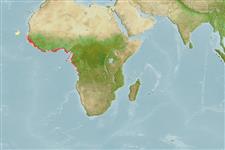Common names from other countries
Environment: milieu / climate zone / depth range / distribution range
Ecología
marino asociado a arrecife; rango de profundidad 12 - 140 m (Ref. 6943). Tropical; 17°N - 17°S, 26°W - 13°E
Eastern Atlantic: Senegal and Cape Verde to the Gulf of Guinea (4°S). Reported from Angola (Ref. 3166).
Tamaño / Peso / Age
Maturity: Lm ? range ? - ? cm
Max length : 11.6 cm TL macho / no sexado; (Ref. 27000)
Short description
Claves de identificación | Morfología | Morfometría
Espinas dorsales (total) : 13; Radios blandos dorsales (total) : 19 - 20; Espinas anales: 3; Radios blandos anales: 15 - 16. Body is silvery white with a black bar running anteriorly from the base of the dorsal spine to the lower jaw passing through the eye and second black bar running vertically from the ninth dorsal spine to the base of the anal fin rays.
A littoral species. Most specimens were collected on soft bottoms (Ref. 6943). Minimum depth range reported taken from Ref. 27000. Oviparous (Ref. 205). Form pairs during breeding (Ref. 205).
Life cycle and mating behavior
Maturities | Reproducción | Spawnings | Egg(s) | Fecundities | Larva
Form pairs during breeding (Ref. 205).
Maugé, L.A., 1990. Chaetodontidae. p. 837-840. In J.C. Quero, J.C. Hureau, C. Karrer, A. Post and L. Saldanha (eds.) Check-list of the fishes of the eastern tropical Atlantic (CLOFETA). JNICT, Lisbon; SEI, Paris; and UNESCO, Paris. Vol. 2. (Ref. 6943)
IUCN Red List Status (Ref. 130435)
CITES (Ref. 128078)
Not Evaluated
Threat to humans
Harmless
Human uses
Herramientas
Special reports
Download XML
Fuentes de Internet
Estimates based on models
Preferred temperature (Ref.
115969): 18.3 - 25.9, mean 20.3 (based on 41 cells).
Phylogenetic diversity index (Ref.
82804): PD
50 = 0.5002 [Uniqueness, from 0.5 = low to 2.0 = high].
Bayesian length-weight: a=0.02239 (0.01117 - 0.04486), b=3.02 (2.85 - 3.19), in cm Total Length, based on LWR estimates for this (Sub)family-body shape (Ref.
93245).
Nivel trófico (Ref.
69278): 3.3 ±0.3 se; based on size and trophs of closest relatives
Resiliencia (Ref.
120179): Alto, población duplicada en un tiempo mínimo inferior a 15 meses (Preliminary K or Fecundity.).
Fishing Vulnerability (Ref.
59153): Low vulnerability (10 of 100).
